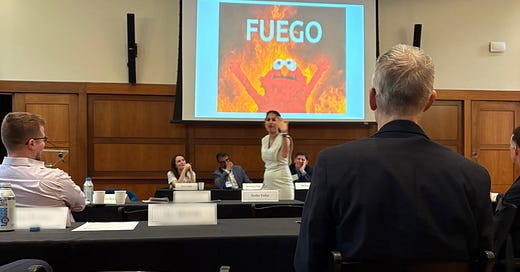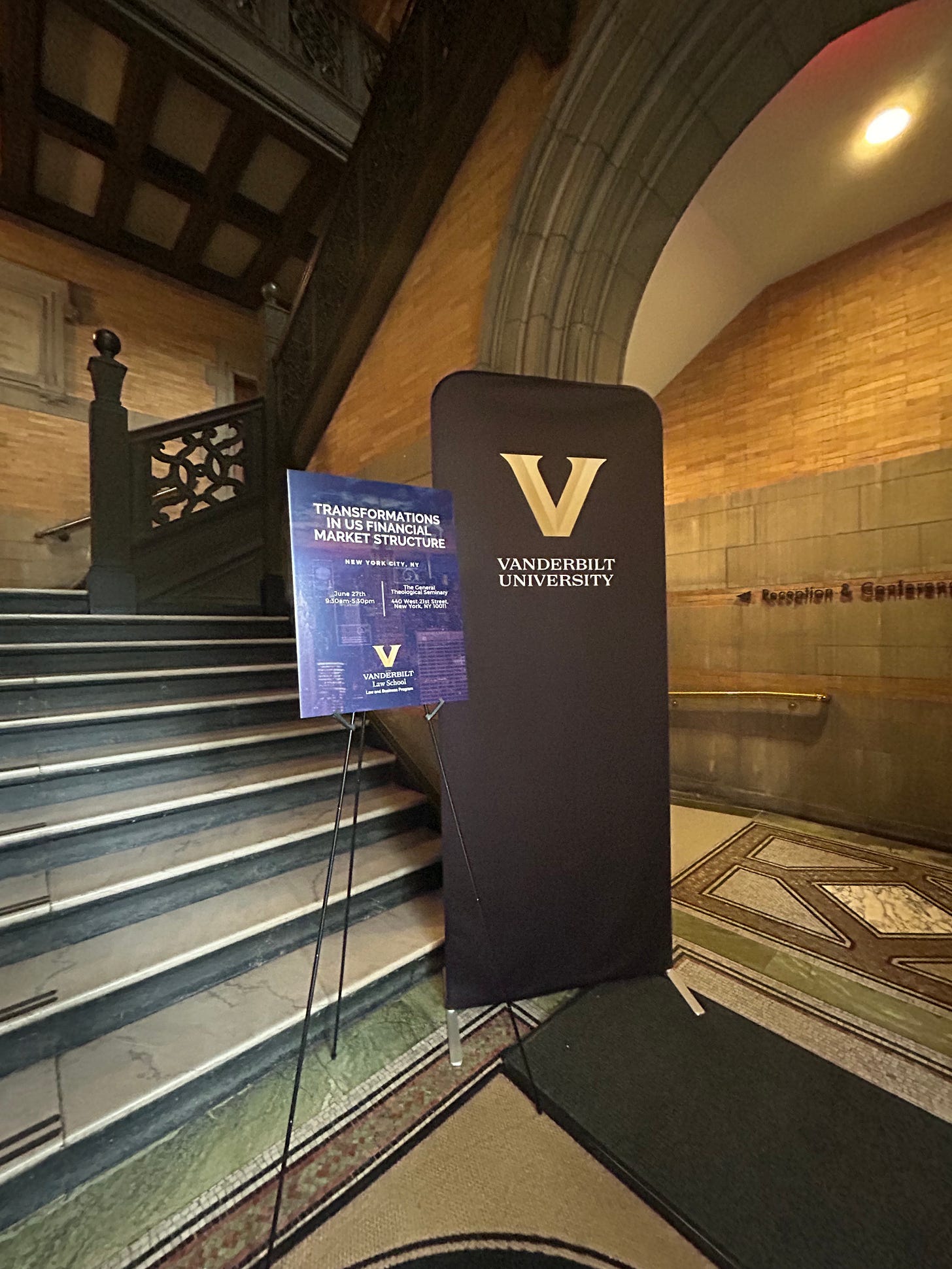I want to tell you about the truly great party I attended last Friday. It was the Vanderbilt Annual Conference: “Transformations in US Financial Market Structure,” hosted by professors Yesha Yadav and Morgan Ricks. Disclosure: Vanderbilt Law paid for me to attend and moderate a panel. I can’t tell you much about what was said because it was Chatham House rules which means I can know what people said (thank god) but cannot share who said it or even who participated.
BUT I can reveal that friend of the newsletter Nathan Tankus was there (because he already revealed it), AND I’m happy to announce that I secured approval — just for you, readers of OFF THE RUN — of this picture of Yesha, below, presenting her thoughts about the Treasury market, courtesy obviously of Dan Awrey. In academic conference panels, everyone gets 10 minutes to say their piece, and THEN the moderator asks questions (it is a different vibe than a non-academic conference!!); Yesha was the fourth of four panelists to present, so we’d already established a sober, restrained vibe. She diverged. In this picture Yesha is blurry because she is moving so fast. In the background you can see me beaming as I watch her ping from one side of the room to the other, hollering about Treasurys.

If you haven’t experienced a Yesha presentation, you should. This is my second time on a stage with her; the first time I was unprepared, and my jaw was on the floor of the stage. This time, after her prepared remarks, I felt compelled to acknowledge that I would not be able to match her energy. I think the room understood.
Yesha’s been a guest on Planet Money a few times — once when I needed someone to explain that LIBOR was not boring, as laypeople often mistakenly believe, and she delivered; again when I needed someone to demystify the Fed’s discount window; and again about how USTs underpin the entire global financial system and perhaps we should not be “playing pickleball with a nuclear weapon economically,” as she put it (by which she meant doing debt ceiling shenanigans).
I quote her yet again in an upcoming piece for Harper’s about the Treasury market, about which you will hear more when it comes out in July. I’m so excited about this piece — I’ve been working on it for months (years?) and am really excited to hear what you think. So we have that to look forward to.
Also in the above picture you can (sorta) see panelist Phil Prince, of Pine River Capital Management. I loved the framework he used for his remarks so much that I asked if I could share it here with you, and he agreed. It’s so clean and useful in understanding the related issues of market structure, volume, collateral velocity and friction…
Here’s Phil (with extremely light edits from me for clarity):
What exactly are we doing this for? What is the US Treasury market (and are related markets) for?
We take as inputs:
The productive capacity of the US population and
The governance structure (fiscal, monetary, regulatory – financial and industrial) of the US
And we produce:
Investments so that wealth can grow along with the economy
Money – a safe asset
So if we step back, way back, and treat the whole thing as a black box, what are the risks to this whole endeavor?
Our governance structure could produce more debt that the productive capacity of the US population can support.
Implicit default – inflate away value (preserve ‘moneyness’ while destroying value
Explicit default
Our governance structure could break down.
Strategic default
The world could demand more safety than the productive capacity of the US population can support.
There is no longer an asset safe in all states of the world – pushing risk out to real economy worldwide
The world could demand more safety than our governance structure allows us to produce.
Market actors step in to provide weak solutions – as in 2008
The conference, of course, will deal with all the risks within the black box - within the production process.
From my perspective, the main risks inside the box are:
Production and delivery of money (in institutional volume) takes place in chains across multiple legal entities, which creates the risk of disorderly default. For instance: Long Term Bond Mutual Funds create extra value through leverage, by managing duration with UST Futures while investing in shorter Corporates and Mortgage-Backed Securities. Hedge Funds create the futures for those funds by buying offsetting UST securities and repoing those UST o/n through rated bank dealers to MMMFs [money market funds] to create money. If there is a breakdown in the Futures clearinghouse OR at the bank dealer, a chain of defaults can start.
Relative value trading can break down, creating a doom loop. The more expensive it is to police the guardrails of relative value, the greater the price impact on a specific instrument of any purchase or sale. The more variable (both absolute and relative) the price of specific instruments, the more margin required to police the guardrails, which increases the expense (capital cost), which increases the variability, which increases the margin, which increases the expense, rinse, repeat.
…me again. Thank you, Phil!!
The word “default” in here is somewhat noteworthy, in the context of Treasurys. lol. Phil was not the only one to mention it. This is new! It’s not that people think it’s likely. But it is now “on the table,” where before it was not. (I also have permission to share that the legendary Mitu Gulati attended this conference, and his presence alone is noteworthy, because his work “focuses on sovereign debt restructurings and the evolution of sovereign debt contracts over history.”) I have let go of the strategic default anxiety, because a bestie of Scott Bessent’s personally assured me that “the US will never default, period,” and I chose to accept that.
A quick note on aesthetics: in my book I write the word “Treasuries” approx 47 times. Upon further reflection, I am now strongly of the opinion that it’s Treasurys, not Treasuries. Because Treasurys are special. Treasury is a proper noun, a name, and thus cannot be pluralized like some common debt instrument or berry. They don’t act in normal ways, seem to not be subject to all of the laws that govern more common instruments (at least to date, ha ha), and it’s nice to reflect that in how we refer to them. Also “Treasurys” looks old-time-y, which feels accurate.
A final bit of documentation of the day: I lost a button.
If you see my button, please let me know!
Other things I’m thinking about:
Depopulation! if you can get past the eugenics, there is something real here — yes immigration but that’s a near-term and country-specific “solution,” because the whole entire human population is projected to peak in the mid-2080s and then begin to decline. There are of course benefits to fewer people on the planet, and sometimes I like to daydream that demographic trends will align perfectly with AI productivity gains, that retraining and reskilling are a breeze and no one will suffer. But as this oped points out, it’s probably more effective to do actual governance than to hope that depopulation solves our problems. For example, declines are not fast enough to solve our climate issues, haha. There is evidence that the trends are accelerating, projections getting pulled forward, so if you want to hope for that, you can….but depopulation also presents enormous economic challenges. The global economy is just not built for this demographic shape!! We have never even had to think about this!! It will be thrilling to cover, if journalism still exists in the future.
I just read the novel Dream State by Eric Puchner, and, alongside my parasocial friend and peer Oprah, I am delighted to recommend this book. I’ll just note it is not great if you are trying to avoid future climate realities. We just hosted him at Richmond’s ICA in our ongoing Author RVA series. (hey — are you publishing a cool interesting book and want to visit Richmond to talk about it to a warm, thoughtful audience in a beautiful room?? get at me!!) I’ll post a link to the transcript of his conversation with my beloved cohost Jessie Gaynor as soon as it’s published.

I forgot to tell you about our FIRST Author RVA event, which we ran on Planet Money Plus (our subscription platform): I got to talk to the brilliant Atossa Araxia Abrahamian about her book, the Hidden Globe. She’s interested in all the best nation-state things, like funeral flags and passports for sale:
“This idea that law and land don't necessarily come together….to borrow an expression, they've become sort of consciously uncoupled, right? You can take law and put it somewhere else. You can take it away from a piece of land and put another piece of law…We shouldn't take these things for granted.”
I recently got to co-create a rap, for an episode of Planet Money called “Econ Battle Zone.” More accurately I was involved in making a beautiful rap song materially worse. I’ll unpack the behind-the-scenes from this soon, because the journey was crazy and very fun and educational, but one big lesson is: rhyming is harder than you think!!
I am proud to announce that I am growing blackberries in my backyard, as an inflation hedge (berries comprise 47% of our monthly household budget.)






